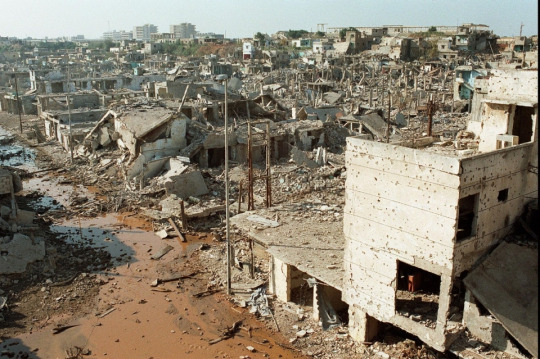New Rho Under Siege - The Locked Tomb
The Locked Tomb series receives a lot of gushing praise (quite rightly) for its intricate and complex depictions of relationships and love, sexuality and gender. But something I've seen less praise for (though I'm sure it exists) is the incredibly rich depiction of what an urban environment during warfare and civil strife looks like.
One of the unfortunate facts of urban warfare is that civilians are almost inevitably present, even in the most dire circumstances. Take the Bakhmut as an example. Despite months of fighting, thousands lived on in the city and region right to at least the very closing moments. This is despite the city being essentially entirely destroyed.
👆 civilians still lived through these conditions.
New Rho in Nona the Ninth feels incredibly lived in. The city supposedly contains ~9 million people, and you can believe it. There are all sorts of people, there are different groups and socio-economic areas, people have different responses to the situation they find themselves under, but they all living complex lives. This goes well beyond the key characters or even the side characters, but is captured by the existence of a barter economy, background vigilante and militia groups, the daily grind of workers desperately seeking ad hoc jobs.
They walked alongside all the other workers - the ones who didn't get picked up in the morning in the worker vans, or didn't have a job that merited a worker van, or didn't have a job but lived in hope - and they all trudged slowly through the street in clusters, parting only when a truck ground through, the driver leaning on the horn if someone didn't move out of the way quick enough.
I reckon some Locked Tomb super fans could pull out all sorts of fascinating little details in the world building of New Rho to discuss here.

The Irish Troubles produced a number of iconic photos showing the dichotomy of urban conflict amongst civilians.
Perhaps one of the best parallels would be life in Palestine, particularly the Gaza Strip. The Gaza Strip, with a population of >2 million has lived under blockade for many years with frequent intervention/incursion by Israel.

One of the interesting parallels with Palestine is the plethora of different actors and resistance groups, just as fractious and secretive as New Rho's Blood of Eden and other militants, and who often seem to spend more time fighting themselves and civilians rather than their main enemy.
The Marxist-Leninist Popular Front for the Liberation of Palestine (PFLP) gave us the splinter groups PFLP-SC (Special Command), PFLP-GC (General Command), PFLP-EO (Executive Order), Palestinian Popular Struggle Front, Democratic Front for the Liberation of Palestine, Popular Revolutionary Front for the Liberation of Palestine, and had complex intertwined relations with groups like the Black September Organisation, Palestinian Liberation Front, Arab Liberation Front, Palestinian National Salvation Front, the Abdul Nidal Organisation, Fatah al-Intifada, Vanguard for the Popular Liberation War - Lightning Forces, and dozens of others. On the Islamist side there is similarly a plethora of groups, from Hamas, to Palestinian Islamic Jihad, Sheikh Omar Hadid Brigade (Islamic State in Gaza), the al-Aqsa Martyrs' Brigade, the Army of Islam, and Jund Ansar Allah. It's almost comical to write them out.
New Rho itself is home to many refugees and "re-settled" peoples, which is somewhat reminiscent of Palestinians and the related conflict spilling into Lebanon, Jordan and other neighbouring areas. The complexity and number of groups involved skyrocket.

Rarely is war as simple as "Good Guys vs. Bad Guys" or even "Bad Guys vs. Bad Guys." There is almost always a vast number of interest groups and competing organisations at stake, even in some of the more black and white wars like WW2. Muir just hits this nail right on the head in my opinion.
You could also make similar parallels to the Syrian Civil War, which has an equally complex mix of militants and groups. Despite all of that, of course, life still goes on. School kids still attend school, even in bullet ridden buildings.
These kids are your Hot Sauce and Honesty and Kevin and Beautiful Ruby.
Typically the books I've read depicting a place under siege or at war (at least in sci-fi / fantasy) have a focus on the main characters leading the war effort. There may be issues of water or food shortages, but they're largely somewhat abstract political complications being dealt with by key rulers or the like. Often times war is simply sanitised completely (think Star Wars), or it is portrayed through a military lens, or when it deals with civilians it focuses on the destruction and death of civilian life.
I just found Nona wonderful in depicting the mundanity, the boredom, the regularity of life in a war zone, as well as the sudden shocks of change and turmoil and fear, and then as well the glimpses of joy and pleasure that humans still experience. I'm just really quite blown away by Tamsyn Muir, and I wonder if she had a specific conflict as inspiration for her writing here.
Note: This post was originally written early 2023. Hence the datedness of the Gaza and Syrian examples









